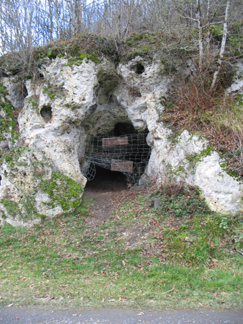 Evidence
that suggests that modern humans lived at the same time as Neanderthals has
been contentious in archaeological circles for many years. A reevaluation of
artifacts from a cave in France, however, has reignited the debate over whether
the two species coexisted some 40,000 years ago.
Evidence
that suggests that modern humans lived at the same time as Neanderthals has
been contentious in archaeological circles for many years. A reevaluation of
artifacts from a cave in France, however, has reignited the debate over whether
the two species coexisted some 40,000 years ago.New research on Neanderthal and human artifacts excavated from this French cave is indicating that the two groups lived here in successive generations, supporting the idea that Neanderthals and humans coexisted. Image courtesy of Brad Gravina.
Archaeological evidence suggests that the Châtelperronians, the last Neanderthals living in western Europe, disappeared around 35,000 to 34,000 years before present (as figured through radiocarbon dating), says Jean-Jacques Hublin, director of the human evolution department at Max Planck Institute for Evolutionary Anthropology in Germany. The Aurignacians, the first anatomically modern humans, appeared in France around 39,000 years before present, and brought with them new technologies, such as tools and ornaments, which were not seen in the 200,000-year record of Neanderthal cultures, Hublin says.
In the early 1950s, archaeologist Henri Delporte excavated the Grotte des Fées cave in central France and recorded a sequence of archaeological levels that extended 2.5 meters deep. Four distinct layers contained more than 750 artifacts from the Châtelperronian Neanderthals, underlain by artifacts of an older Neanderthal culture. In between the lowermost and upper three Châtelperronian layers is a layer that looked different, says Paul Mellars, an archaeologist at the University of Cambridge in the United Kingdom, and co-author of a paper in Nature, published online on Aug. 31. That layer contained Aurignacian tools and artifacts such as jewelry and reshaped blades made from a different, nonlocal type of stone.
Delporte recorded this anomaly, but did not press the issue when he published on his find because “the idea of a Neanderthal-human overlap would have been considered heretical at the time,” Mellars says. So instead, the bones and artifacts were cataloged and tucked away in a French museum for 50 years, until Cambridge graduate student Brad Gravina found them this year.
As radiocarbon dating was just a budding technology and unproven when Delporte published, the bones and artifacts had never been dated. Gravina and Mellars brought the remains to England, where they ran accelerated mass spectrometry radiocarbon dating analyses. The dates were conclusive, Mellars says: Châtelperronians lived in the cave around 40,000 years before present, then left, and returned again sometime after 36,000 years before present. In between, from 39,000 to 36,000 years before present, Aurignacians set up camp in the same cave.
“We cannot say how long any of these cultures occupied the site,” Mellars cautions. “It could have been a few weeks to a few hundred years. But we can demonstrate that these two cultures coexisted.”
Mellars and colleagues’ evidence that Châtelperronians and Aurignacians overlapped is “strong and very important,” Hublin says. Other archaeological sites in France and Spain have shown “interstratification” of Neanderthals and humans, he says, but they were not as conclusive as this site, which “provides a very consistent and solid series of dates that supports the same contemporaneity and possible contacts.”
The researchers also correlated the occupant changes to climatic changes. Deep-sea paleoclimate cores indicate that around 40,000 years before present, the climate in Europe began growing colder. Neanderthals likely moved south to warmer climes and humans moved in from colder areas to the east, around present-day Germany. Then around 36,000 years before present, the climate began to warm, at which time Mellars speculates that humans moved back north and east, and the Neanderthals returned to central France. When the climate cooled again following a brief warm period, it appears the Neanderthals were again driven out. Whether climate played a part in their extinction, however, is unknown, Mellars says.
Additionally, to what extent the two species interacted — through trade, war or sex — has remained, and will likely remain, highly contentious, Mellars says. New evidence from the cave and other sites, however, continues to provide examples of possible contact between the two groups, something Hublin says will remain an important area of research.

